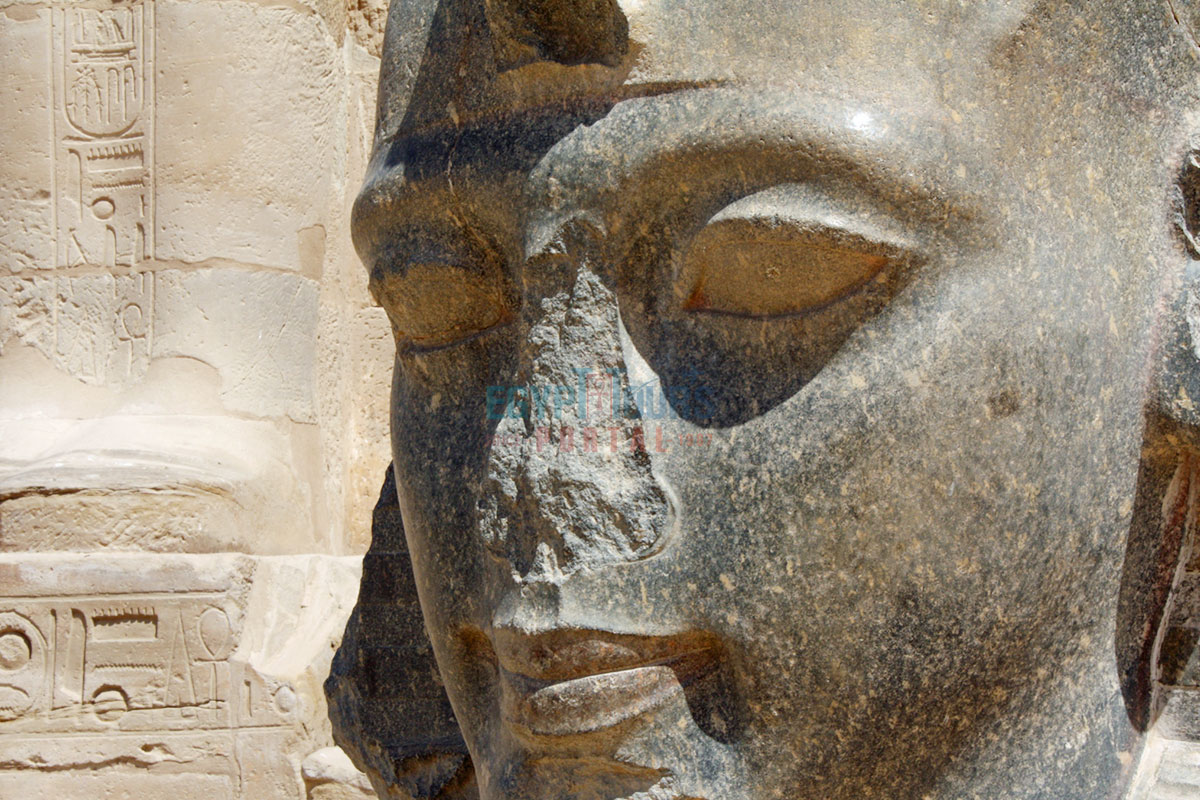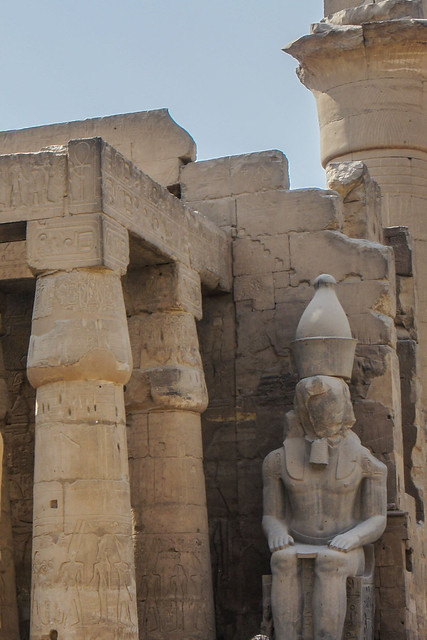Introduction
Towering at the entrance of the magnificent Luxor Temple, the colossal statue of Pharaoh Ramses II stands as an awe-inspiring symbol of Egypt’s ancient grandeur and the divine authority of one of its most powerful rulers. This masterpiece not only embodies the religious and political stature of Ramses II but also serves as a testament to the exceptional engineering and artistry of the New Kingdom period. As both a king and a god-king, Ramses II’s legacy continues to captivate millions of visitors who marvel at his monumental contributions to Egyptian civilization.

Ramses II: The God-King
Seated in a commanding and regal pose, Ramses II is immortalized as more than a mere monarch—he is depicted as a god-king, a figure deeply revered by his people during his reign. His colossal statue, crafted from solid granite, symbolizes his divine connection to both the gods and his subjects. The pharaoh’s pose, with one hand resting on his knees and the other clutching a symbolic staff, reflects his supreme power, stability, and his role as both a military leader and protector of Egypt.
Ramses II’s long and prosperous reign, which lasted for 66 years, is widely regarded as one of the most successful in ancient Egyptian history. During this time, he not only expanded Egypt’s borders but also undertook numerous architectural projects, leaving behind a legacy of monumental temples, statues, and obelisks. The statue at Luxor Temple remains a significant reminder of his enduring influence and status as a living deity worshipped by generations.

The Artistic and Architectural Significance
The colossal statue of Ramses II is more than just a monument to a powerful ruler; it is a masterpiece of New Kingdom art and engineering. Standing at approximately 12 meters (40 feet) tall, the statue is one of several that once flanked the entrance to Luxor Temple. The sheer size of the statue reflects the ambition and power of the pharaoh, while the intricacy of its design demonstrates the exceptional skill of ancient Egyptian artisans. The meticulous craftsmanship, visible in the detailed facial features and the regal attire of the statue, reveals the artistic sensibilities of the period.
Intricate Hieroglyphic Inscriptions
Surrounding the statue are intricately carved hieroglyphs, which offer deeper insights into Ramses II’s reign and Egypt’s religious and political life. These inscriptions celebrate the pharaoh’s numerous military victories, particularly his triumphs over foreign invaders such as the Hittites, and his divine right to rule as granted by the gods. The carvings also emphasize the connection between the pharaoh and the gods, reinforcing his role as both a leader and a deity.

These hieroglyphs are not only religious symbols but also serve as historical records that immortalize Ramses II’s accomplishments and the cultural achievements of the New Kingdom era.
The Monumental Entrance to Luxor Temple
The placement of the colossal statue at the entrance of Luxor Temple amplifies its significance. Flanked by other statues and obelisks, the statue forms part of a grand architectural ensemble that greets visitors as they approach the temple. This strategic positioning underscores the temple’s importance as a religious and political hub in ancient Thebes (modern-day Luxor). The colossal scale of the entrance, with towering pylons and rows of statues, leaves visitors in awe, symbolizing the grandeur of Egypt’s empire during the height of its power.
The alignment of the temple with the annual Opet Festival, a major religious event in ancient Egypt, further emphasizes the statue’s role in connecting the earthly realm with the divine. During this festival, statues of the gods Amun, Mut, and Khonsu would be paraded from Karnak Temple to Luxor Temple, symbolically renewing the pharaoh’s divine mandate to rule. The colossal statue of Ramses II thus stands not only as an artistic marvel but also as a symbol of religious continuity.
Ramses II’s Enduring Legacy
Beyond its immediate architectural grandeur, the colossal statue of Ramses II holds significant cultural and historical importance. Ramses II is often regarded as Egypt’s greatest builder, and his architectural contributions have left a lasting mark on the country’s landscape. His construction projects, which include the famous Abu Simbel temples, the Ramesseum, and the statues at Luxor, reflect the immense resources and labor available to the pharaoh, as well as his ambition to immortalize his reign.

The colossal statue at Luxor Temple remains one of the most iconic representations of his legacy, embodying the splendor of his rule and the brilliance of Egypt’s ancient civilization. Even today, the statue continues to draw visitors from around the world, offering a glimpse into the extraordinary world of ancient Egypt and the enduring power of its rulers.
Conclusion
The colossal statue of Ramses II at Luxor Temple is not just a monument to a single ruler but a symbol of Egypt’s incredible architectural achievements, cultural heritage, and the enduring legacy of one of its greatest pharaohs. From its intricate inscriptions to its towering height, the statue reflects the extraordinary craftsmanship of New Kingdom artisans and the divine status of Ramses II. As visitors stand in its shadow, they are reminded of the power, ambition, and glory of ancient Egypt, a civilization whose achievements continue to inspire awe across millennia.

